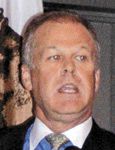CMS enlists pharmacies in drug plan enrollments
Hoping to stem a new season of confusion over Medicare's Part D prescription drug benefit, the Centers for Medicare & Medicaid Services is asking pharmacists to prepare patients for the upcoming enrollment period.

The Nov. 15 through Dec. 31 enrollment period is open to new enrollees and existing participants who want to switch drug plans. CMS is planning to launch its own marketing campaign for enrollment in October, while prescription drug plans will be mailing annual notices of change that include a summary of their 2007 premium, benefits, and formulary to all existing enrollees.
"We're putting in a lot of time and energy, and we really need everyone's help," said Larry Kocot, senior adviser to the administrator at CMS, at the recent National Association of Chain Drug Stores Pharmacy & Technology Conference in San Diego.
"You have to be careful to balance their interests against yours and make sure their interests come first," said Kocot. "That's the extent of our guidelines on that."
The Medicare prescription drug program already has 38.2 million enrollees after the first enrollment period, from Jan. 15 to May 15 of this year. CMS wants pharmacists to encourage patients to enroll as early as possible and certainly by Dec. 15 to avoid problems when the new plan period starts Jan. 1, 2007.
The shorter enrollment period is likely to cause some mix-ups, according to Scott Hughes, VP of business development for MemberHealth. "You're going to have seniors thinking they're going to have five or six months to enroll again, and they're not," he said. "You need to get out in front of the game."
A significant cause of confusion is expected to be the coverage gap or so-called donut hole, which an estimated 3.4 million to six million people are expected to fall into this year once their coverage limits are exhausted. A PricewaterhouseCoopers study recently concluded that 3.4 million people will be fully responsible for all their drug costs during the gap period. Others will have access to supplemental coverage and discounts to mitigate out-of-pocket costs.
This complicated provision of the law was designed to force patients to pay 100% of their prescription drug costs after reaching a certain spending threshold, currently set at $2,250. Once they reach the threshold, seniors must cover their own drug costs until they have spent $3,600 of their own money. Then Medicare Part D kicks in again to cover 98% of their costs for the remainder of the year. The spending levels are expected to rise in the future because they are indexed to drug costs, according to AARP.
Hughes said pharmacists will start seeing patients as early as January who are facing major drug expenses. He expects the flow to peak in July and subside again as the gap closes.
Another major issue will arise when some enrollees are found to be no longer eligible for certain levels of coverage, such as limited income subsidies. Kocot said CMS will be sending notices this fall to enrollees who are losing their "deemed" status or who will have a change in status that affects their co-pay.
"Every year people do fall out of coverage," said Kocot. "That's going to come as a shock to some of these people, who are going to need an explanation." CMS will be sending out applications for low-income subsidies to patients who are falling out of status and will need to reapply. "They're going to be coming to you," he said.